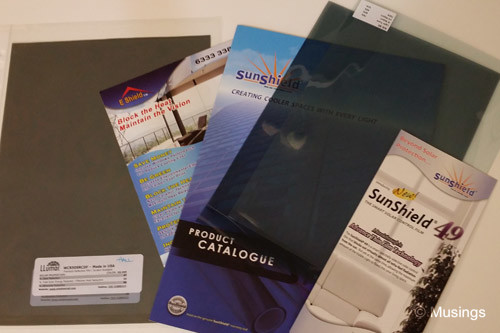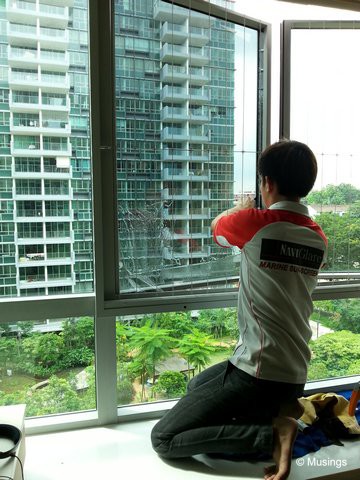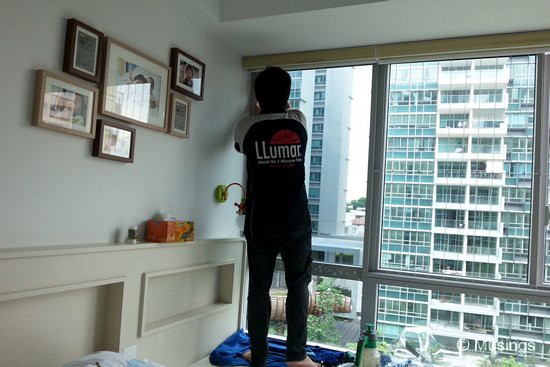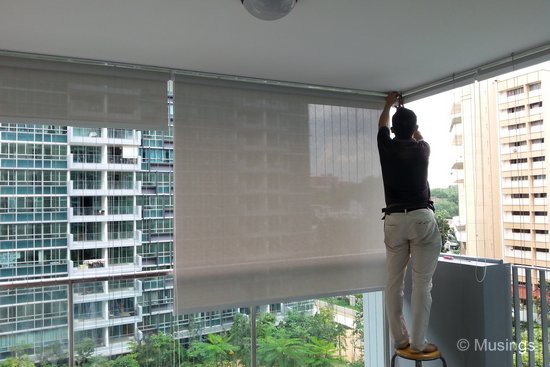Most new condo projects on our island routinely try to design their blocks such that each unit’s living and bedroom areas are in the north-south orientation, and in so doing avoid the afternoon sun that can otherwise blast unrelentingly into the rooms. Most of the units in The Minton are north-southerly facing (with the exception of one block!), including ours.
A year ago while I was doing my fortnightly photo-visits to the ongoing construction site then, I observed that our front balcony would get some morning sun. Not quite an issue for us. And when keys were collected in January this year, we again observed that there would be some mild afternoon sun getting into Peter’s room – but not the other bedrooms. Whew – we thought. But then, exactly as Ling feared, this was a seasonal thing, and since 3 weeks ago, our Tranquil World facing bedrooms have been getting some direct sunlight into the rooms. Not full-on thankfully in the east-west sense, but sufficient to heat up the room to the point that it’s noticeable. Hannah’s room and our workroom are especially affected, since the Zebra blinds we’ve got there can’t block a sufficient amount of sunlight.
So, we had to look into window films and specifically of the solar control type. There were already several advertisers promoting their various brands on different web sites and the like, and it was some intensive fact-finding on our part. And also because solar control films are a commonly-requested product for new built-up apartments on a hot and humid equatorial island, our mail box over the last months have been stuffed with flyers and brochures from many, many window film contractors.
Without getting too much into our exploration process, what we’ve learned in the last one week – from deciding to go with films to learning about the different film types and specifications to inviting different contractors down for measurements to deciding who to go with and finally actual installation – include:
Competition in this industry seems extremely intense. We heard and read of stories of companies badmouthing their competitors products.
The more affordable films seem compacted around the same price range (about $4 to $6 per square foot).
Most films we saw all offered 99% UV rejection, and Solar energy Rejection was routinely between 45% to 55%. The other characteristics (Visible Light Transmission, Warranty, Infra-red Rejection) varied significantly however.
Some characteristics of the film are (a lot) more important than others. The important ones are Total Solar Energy Rejected and Visible Light Transmittance if you’re also concerned about how much darker your room might be once films are installed.
With regards to the last point, there are quite a few online resources that debate on the often-cited Infra-red rejection film characteristic how what it really means, including here, here and here. The long and shot of what those resources all say is that IR rejection statements needs to be read with caution.

As for the other characteristics; after having been convinced about the importance of the selected film characteristic indicators, we invited several film contractors down for their sales pitches, measurements and quotations. Not quite easy deciding between the lot, but we eventually settled on LLumar solar control films, and with a contractor who was its local distributor. The film manufacturer seemed well-established and having been in the business for decades, and their films well-reviewed and received too and used across different purposes. The cost per square foot of their solar control films were just a little higher than their competitor products, but we were persuaded to take up their package largely on account that their films seemed in our exploration to be most premium of the bunch.
The installation took 2 afternoons, and we had different film types installed for the living/dining halls and the bedrooms. The two films’ Visible Light Transmittance was 48% and 60% for the Living/Dining halls and bedrooms respectively, and both offered 53-54% Total Solar Energy rejections. Total damage was almost $1.9K. Ouch!
Photos.:)



Hello-! Came across yr blog as I was searching for ceiling fan recommendations for my new home. Can I check where did u do yr roller blinds and the cost and contact? Am keen to do this for my new place. Thanks.
Hey there; thanks for the visitation to our blog. I’ll email you the contact in a bit.
Hi CY, can you send me the contact and quotation for your balcony blinds and room timber blinds? I just got a unit at the Minton too :)
Sure. Will email you later.
Hi Patricia,
If you’re getting balcony blinds, do go for one-piece roller blind for the width of the balcony. We went for 2-piece and whenever it rains the rain water always get blown into the balcony through the gap between the 2 pieces. The wind around Minton is quite strong. Ours is north facing.
Do you guys do balcony roller blinds in North Hollywood, California
Hi CY, chanced upon your blog during my search for crestar fan. I am currently in the midst of renovating my new apt. Your write up on your reno journey are really interesting to read and helpful. Am encouraged to try LLUMAR solar film. I am also considering to use their outdoor roller blind. But the quote is pretty steep. Can share your review
Haha…finger trouble… sent b4 I complete my msg. Wld u mind sharing your experience on the product and quote? Wishing you and your family a great weekend ahead ! Take care : )
Thanks for the visit to our blog, and sure – will reply you with the information in a bit.